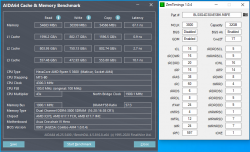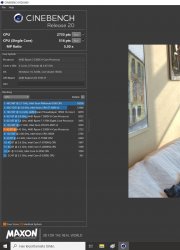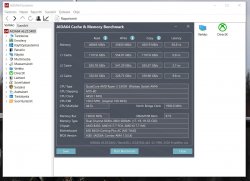- Liittynyt
- 20.12.2016
- Viestejä
- 1 417
@mv. jussi joo muistit olivat vakio 2400 MHz kun testailin tuossa eilen alkuun vain prossun kulkuja. Kyseessä siis uusi prossu joten en halunnut sekoittaa pakkaa muistikelloilla. Plus Cinebench ei tunnu niin hirveästi välittävät muisteista (IF:stä en ole varma tuoko paljoa lisäpojoja?). Tänään toki otin löysät pois muistien osalta eli 3600C16 (Micron Rev E 4x8GB). Testasin myös IF-kulkuja ja tämä yksilö ainakin boottasi 1900 MHz mutta en testannut vakautta kummemmin kun se vie aikaa. 1933 MHz ei bootannut.
Aamulla kun oli aikaa, kokeilin myös 4,6 GHz @ 1.3V, mutta ei ollut CB20-vakaa. 4,55 GHz sain ajettua. Jäähynä toistaiseksi Noctua NH-U12A. Odottelen tässä Jimssiltä Scythe Fuma 2:sta. Eihän se jäähdytysteholtaan parempi ole (tai testien mukaan paljoa huonompikaan), mutta halvempi ja mielestäni paremman näköinen. Noctuan tulen myymään ja eiköhän siitä saa kelpohinnan
4,55 GHz CB20 veto alla:
Aamulla kun oli aikaa, kokeilin myös 4,6 GHz @ 1.3V, mutta ei ollut CB20-vakaa. 4,55 GHz sain ajettua. Jäähynä toistaiseksi Noctua NH-U12A. Odottelen tässä Jimssiltä Scythe Fuma 2:sta. Eihän se jäähdytysteholtaan parempi ole (tai testien mukaan paljoa huonompikaan), mutta halvempi ja mielestäni paremman näköinen. Noctuan tulen myymään ja eiköhän siitä saa kelpohinnan
4,55 GHz CB20 veto alla:
Rykäsin nyt sit viel 4,55GHz vedon @ 1.3VCore (SVI2 TFN)Aivan rajoilla mennään eikä tolla NF-U12A:lla huvita enempiä kokeilla eli laitampas kiltisti nyt kellot ja voltit reilusti alas
tonkar/530/4188/AMD Ryzen 5 3600/4.55 GHz/KR/DDR4-3600-16-19-16-36-58-1T
(molemmat tulokset Realtime Priorityllä, en kuitenkaan "lotonnut" parempaa tulosta vaan noi on mitä tuli ensilaakista)



 .
. ).
).
 Vähän harmilliset matalat turbot näissä 3100 kivissä.
Vähän harmilliset matalat turbot näissä 3100 kivissä.




